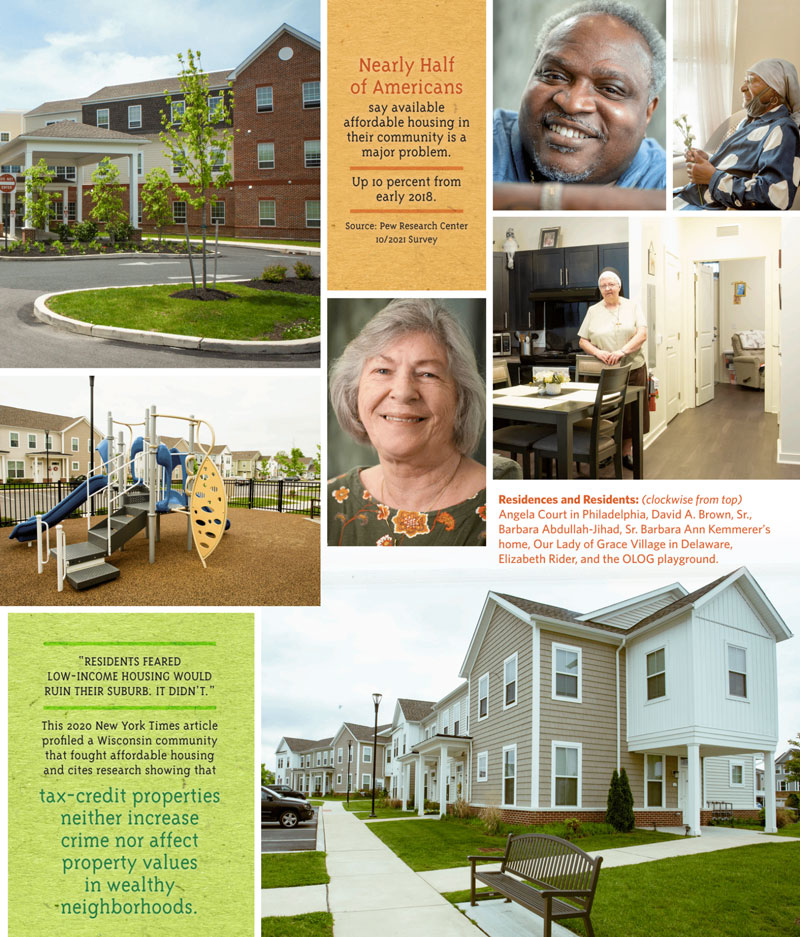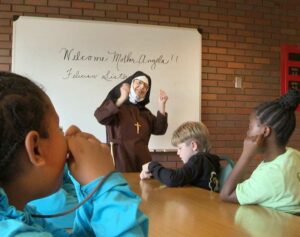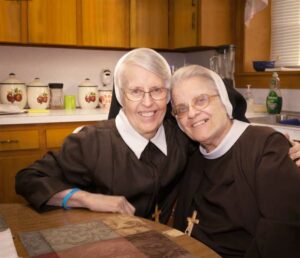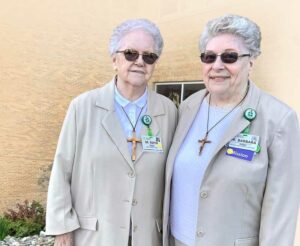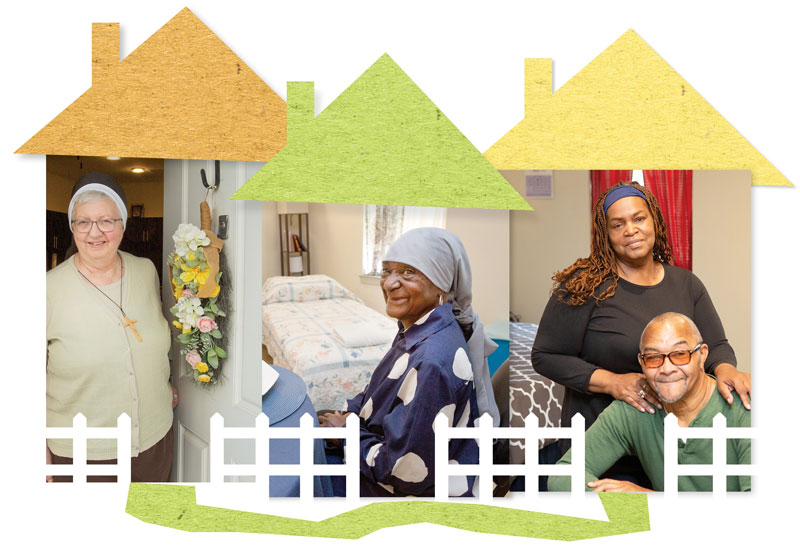
In the Community: Sr. Mary Barbara Ann Kemmerer, Barbara Abdullah-Jihad,
and Debra and Ray Usher.
David A. Brown, Sr., has a round face, a silver goatee, a ready smile for everyone he encounters, and a generous spirit. “If my neighbors need anything and I got it, I’ll give it to them,” he says. He hasn’t lived in Delaware long, and he moved there just before the pandemic, but already he feels deeply connected to his community. In early 2020, after the death of his wife, he came to Delaware from Youngstown, OH, to live closer to his brother. Moving to a higher-priced region of the country, he needed a place with affordable rent and handicap accessibility. Mr. Brown says, “When I heard of the name of Our Lady of Grace Village…something lit up in my spirit.” This enkindling of the human spirit is precisely the goal of Felician affordable housing communities, where people who might be otherwise excluded from the American dream have an opportunity to live with dignity.
If the American dream promises home ownership, then the American nightmare might entail facing the impossibility of finding a shelter from the storms of life. Unfortunately, and often through no fault of their own, many Americans are excluded from the kind of security and stability afforded by a safe and clean place to live, and a community to which they can belong.
Among homeowners, despite a growing realization that more diverse schools, workplaces, and communities provide both short-term and long-term benefits for all participants, Americans on both sides of the political divide seem to dig in their heels about diversifying their own neighborhoods. In the name of “public safety,” “preserving history,” or “protecting property values,” homeowners fiercely and even irrationally work to prevent the kinds of affordable housing communities that would offer real, stable, and sustainable diversity, acting out of fear or suspicion rather than out of a desire for encounter. Once high-quality and well-maintained affordable housing goes into a community however, people want to live there, and everyone benefits from the increased economic diversity.
Our Lady of Grace Village in Newark, DE, was built on the site of a former orphanage that served the most vulnerable children in the area from the 1930s until 2009. When the Felician Sisters considered what to do with this property, they renewed their commitment to help the most vulnerable.
The community, built with easy access to public transportation, includes twelve residential buildings, with a mix of one-, two-, and three-bedroom apartments or townhouses, each with its own washer and dryer. The spacious units have finishes comparable to market-rate rental units in the area, and the community offers a central gathering place, a fitness room, maintenance offices, and supportive services for residents — as well as green and sustainable design features. Several of the residents have commented about how desirable their buildings are. Frequently, passers-by stop in the office to inquire about purchasing a unit, not realizing that they are exclusively subsidized rental housing. Shannon Baxter, property manager, comments, “The Felician Sisters are very supportive. They’re very involved.” As a result of the Felician touch, the units blend into the neighborhood beautifully.

Resident Lloyd Danette has a slim, athletic build. He moved to Our Lady of Grace Village in 2020 with his young daughter, opening what feels like a new chapter in his life. A single dad since he was just 20, he had sometimes had to depend on relatives for a stable place to live. He appreciates the freedom he has found at Our Lady of Grace Village, where he says, “You can actually go write a story or read a book or watch a movie, whatever it is that you like to do…knowing that even in the turbulent times we live in… that place is consistently yours.” Mr. Danette already wants to give back to the community that has welcomed him and his daughter. A skilled hip hop dancer, he has begun teaching dance lessons at a neighboring church. About his new home, he says, “I wish that there were more places like this.”
Like Mr. Danette, Elizabeth Rider appreciates the multi-generational aspect of Our Lady of Grace Village. A gracious woman with a chin-length silver bob and a direct gaze, she describes the way she has connected with younger families: “I have a neighbor that has two children, and when she moved in, I gave her my phone number and she gave me hers so that we could help each other if needed…I’m really grateful that I’m here and I’m grateful that they built it the way they did.” Ms. Rider describes Our Lady of Grace Village as “the perfect place.” She says, “It’s a small community… but that makes it more family-oriented. It’s low income; it’s not senior income, which is fine… When you’re living in a low income with families, it just makes you feel alive much more because you see the kids and different families and it just makes you feel better.”
Francis House in Philadelphia, another Felician ministry, has six “neighborhoods” of ten units each. Debra and Ray Usher, who have been married for 23 years, are grateful to be part of this community. They previously owned a home in a neighborhood that depreciated in value. Having endured gunshots and increasing crime, they felt desperate to find a safer place to live — but they could not sell their house for as much as they had paid for it. Debra credits the Felician Sisters with a vision for a diverse, safe, and welcoming community.
“I appreciate the fact that this vision that they had came to fruition… I’m so grateful for the sisters who built this house.”
Ray echoes his wife’s sentiment: “Now we’ve got a nice place. Everything’s gorgeous. We thank the sisters for everything!”
Single parents, the elderly, essential workers, young people, caregivers, those with disabilities. As the cost of rent has outpaced inflation in the U.S., many factors have contributed to a lack of available rental units, and many Americans simply cannot afford the soaring cost of housing. The Felician Sisters, faced with a surplus of housing as the number of sisters has decreased, have prayerfully considered how best to follow Blessed Mary Angela’s imperative to “always seek the glory of God and the good of your neighbor.” Former orphanages, schools, and convents can provide safe shelters for those who need them, with Felician spirituality guiding construction and infusing communities with joyful opportunities for encounter. As Sisters Mary Laureann Alexandrowicz and Anita Marie Taddonio wrote in a recent op-ed piece about a new affordable housing community in Enfield, CT: “The redevelopment isn’t solely about creating much-needed housing for our neighbors. It’s about lovingly and responsibly investing into our community, our home and future.” David Brown, who lives in Our Lady of Grace Village, echoes this sentiment when he says, “The thing is, I’m a firm believer that you love your neighbor as yourself.”
